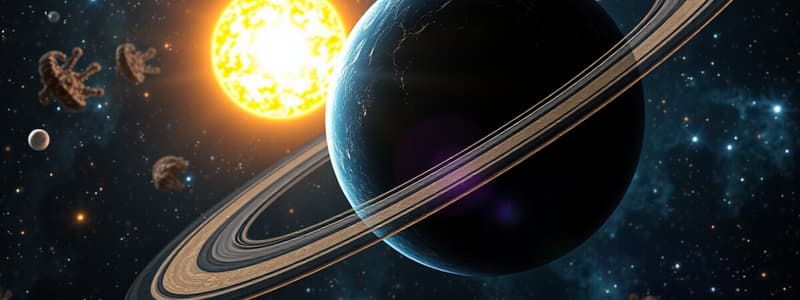Podcast
Questions and Answers
Which of the following best describes the primary difference between inner and outer planets?
Which of the following best describes the primary difference between inner and outer planets?
- Inner planets are gas giants while outer planets are rocky.
- Inner planets are smaller and rocky, whereas outer planets are larger and gaseous. (correct)
- Inner planets contain more moons than outer planets.
- Inner planets revolve around the sun at a faster rate than outer planets.
What is primarily contained within the nucleus of a eukaryotic cell?
What is primarily contained within the nucleus of a eukaryotic cell?
- Ribosomes
- Cell membrane
- Cytoplasm
- DNA (correct)
Which of the following is a characteristic of prokaryotic cells?
Which of the following is a characteristic of prokaryotic cells?
- They contain a defined nucleus.
- They lack a clearly defined nucleus. (correct)
- They are larger than eukaryotic cells.
- They have membrane-bound organelles.
What type of celestial bodies are found in the asteroid belt between Mars and Jupiter?
What type of celestial bodies are found in the asteroid belt between Mars and Jupiter?
Which organelle is primarily responsible for energy production in a cell?
Which organelle is primarily responsible for energy production in a cell?
Flashcards are hidden until you start studying
Study Notes
النظام الشمسي
- تعريف النظام الشمسي: مجموعة من الأجرام السماوية التي تدور حول الشمس.
- الشمس: النجم المركزي، مصدر الضوء والحرارة.
- الكواكب:
- الكواكب الداخلية:
- عطارد، الزهرة، الأرض، المريخ.
- صخرية، أقرب للشمس.
- الكواكب الخارجية:
- المشترى، زحل، أورانوس، نبتون.
- غازية، أكبر حجمًا، بعيدة عن الشمس.
- الكواكب الداخلية:
- الأقمار: أجسام تدور حول الكواكب، مثال: القمر الذي يدور حول الأرض.
- الكويكبات: أجسام صغيرة بين المريخ والمشترى، مثل حزام الكويكبات.
- المذنبات: أجسام تتكون من الثلج والغازات، تظهر ذيلًا عند الاقتراب من الشمس.
- الفضاء الخارجي: يحتوي على النجوم، المجرات، والثقوب السوداء.
الخلية وأنواعها
- تعريف الخلية: الوحدة الأساسية للحياة، تتكون من عدة مكونات.
- الأنواع:
- الخلية الحقيقية النواة:
- تحتوي على نواة واضحة.
- مثال: خلايا الحيوانات والنباتات.
- الخلية بدائية النواة:
- لا تحتوي على نواة واضحة.
- مثال: البكتيريا.
- الخلية الحقيقية النواة:
- مكونات الخلية:
- السطح الخارجي (الغشاء الخلوي): يتحكم في دخول وخروج المواد.
- النواة: تحتوي على المادة الوراثية (DNA).
- السيتوبلازم: المادة الهلامية التي تحتوي على العضيات.
- العضيات:
- الميتوكوندريا: مركز توليد الطاقة.
- الشبكة الإندوبلازمية: مسؤولة عن تصنيع البروتينات والدهون.
- جهاز جولجي: معالجة وتوزيع البروتينات.
- وظائف الخلايا:
- التكاثر، النمو، الاستجابة للبيئة، إنتاج الطاقة.
The Solar System
- Definition: A collection of celestial bodies orbiting around the sun.
- Sun: The central star, serving as the primary source of light and heat in the solar system.
- Planets:
- Inner Planets: Mercury, Venus, Earth, Mars; rocky composition and closer proximity to the sun.
- Outer Planets: Jupiter, Saturn, Uranus, Neptune; gaseous composition, larger size, and situated farther from the sun.
- Moons: Natural satellites that orbit planets; for instance, the Moon orbits the Earth.
- Asteroids: Small celestial bodies found mainly in the asteroid belt between Mars and Jupiter.
- Comets: Icy bodies that develop tails when approaching the sun, due to sublimation of ice and gases.
- Outer Space: Contains stars, galaxies, and black holes, highlighting the vastness beyond the solar system.
Cells and Their Types
- Definition: The fundamental unit of life, comprising various components working together.
- Types of Cells:
- Eukaryotic Cells: Have a defined nucleus; examples include animal and plant cells.
- Prokaryotic Cells: Lack a defined nucleus; exemplified by bacteria.
- Cell Components:
- Cell Membrane: The outer layer that regulates the entry and exit of substances.
- Nucleus: Houses genetic material (DNA) and controls cellular activities.
- Cytoplasm: The gel-like substance filling the cell, containing organelles.
- Organelles:
- Mitochondria: The powerhouse of the cell, producing energy through respiration.
- Endoplasmic Reticulum: Involved in the synthesis of proteins and lipids.
- Golgi Apparatus: Processes and distributes proteins within the cell.
- Functions of Cells:
- Processes include reproduction, growth, response to stimuli, and energy production.
Studying That Suits You
Use AI to generate personalized quizzes and flashcards to suit your learning preferences.




